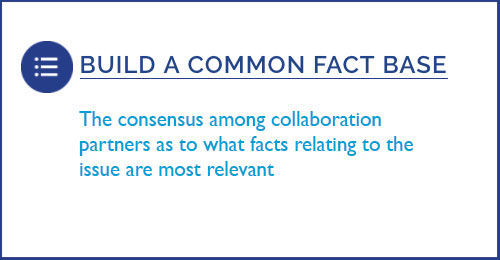Jan 10 2017 Diving Into The Intersector Toolkit: Build a Common Fact Base
 We recently updated our Toolkit for Intersector Collaboration to provide even more useful advice to practitioners involved in cross-sector collaborations. Each week we’ll be profiling one of our 17 tools, with a focus on resources that can help collaborations succeed.
We recently updated our Toolkit for Intersector Collaboration to provide even more useful advice to practitioners involved in cross-sector collaborations. Each week we’ll be profiling one of our 17 tools, with a focus on resources that can help collaborations succeed.
In collaborative environments characterized by shared decision-making authority, developing agreement on the facts that define “the problem” is an often overlooked but crucial step. This process — which The Intersector Toolkit refers to as Build a Common Fact Base — often presents an early challenge for collaborations, as partners may come to the table with sector- and organization-specific biases that influence their perspective on “What’s really wrong here?” Consider, for example, a local initiative to improve public transportation: One partner may contend that lack of accessibility contributes to lack of ridership, causing the key issue, while another may argue that operational efficiency is the root of the problem.
The most effective collaborations take the time to facilitate processes through which partners can communicate their differing views on what facts are relevant and take actionable steps to build consensus among partners — whether through independent information gathering (see this Intersector Project case study for an example), consensus-oriented facilitated discussion, or other avenues.
There are several resources that we recommend to assist collaborative partners in framing and understanding an issue in a way that’s amenable to all partners and reflective of the complex challenge the collaboration seeks to address. For example, the Problem Assessment activity from the European Commission’s Partnership Development Toolkit (found on pp. 17-19) offers step-by-step guidance for partners to complete a problem assessment — an interactive activity wherein partners exhaust their understanding of the problem the collaboration wishes to tackle. “If one identifies a problem wrongly, the solution is also going to be wrong: that is why problems must be expressed in concrete and factual terms,” the Toolkit’s authors write.
For guidance on assessing how key stakeholders approach the problem and identify priority issues, partners can also consult the Community Tool Box’s Assessing Community Needs and Resources Toolkit, particularly points 3, 4, and 5. The Tool Box also provides resources for gathering evidence to indicate whether the problem should be priority for the collaboration and identifying barriers and resources for addressing the issue. The goal of the assessment is to select and state the priority issue or issues to be addressed by the group.
Additionally, Using Information in Multi-Party Decision-Making in Spark Policy Institute’s Tools for Complex Decision-Making provides guidance on navigating the differences in how multi-sector stakeholders value and view information. Partners who desire a visual representation of the issue at hand can consult the Rich Picture and Problem Tree Analysis exercises of the Centre for Development Innovation’s Tools for Analysing Power in Multi-stakeholder Processes: A Menu (found on pages 6 and 8). These two brief drawing exercises invite multi-stakeholder partners to visually express their differing viewpoints on the causes, consequences, and context of the problem.
See Build a Common Fact Base in our Toolkit for further discussion on this topic, questions to guide tool use, and more.
Explore the full Toolkit and each of the 17 tools with enhanced discussion, questions to guide tool use, and additional resources here.
